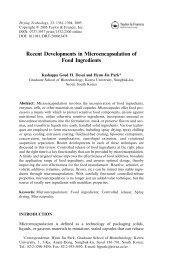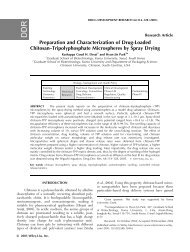2.6. Statistical analysis Statistics were performed with the analysis of variance (ANOVA) using SAS (version 9.1, SAS Institute Inc., Cary, NC, USA). Differences among mean values were processed by Duncan’s multiple range tests and the least significant difference (LSD). Significance was defined at a level of p < 0.05. 3. Results and discussion 3.1. The effect of solvent on properties of nanoparticle The solvent in the oil phase dissolves into the aqueous phase and then, evaporates in the O/W emulsion solvent evaporation method. The extent and speed of solvent transfer from the oil phase into the aqueous phase depends on the solubility. The solvent composition can be a key factor in controlling the solvent removal rate and the final size of the microspheres (Maia & Santana, 2004). In this study, the particle mean size of the nanoparticles prepared by DCM:ACN as the solvent in the oil phase was smaller than that prepared by DCM only (Fig. 2). The water-miscible solvent quickly diffused out of the polymer solution. Then, DCM was removed leading to hardening of the capsule (Luong-Van, Grondahl, Nurcombe, & Cool, 2007). The water solubility of ACN was greater than DCM and therefore the rate of precipitation was higher than the rate with DCM. Due to the high water solubility of ACN, it had higher diffusion rate before hardening. This was the major reason for the smaller particle mean size prepared by mixture of DCM and ACN (Kim et al., 2005). In this study, encapsulation efficiency was increased when DCM was used as the solvent in the oil phase (Fig. 3). By increasing the particle mean size, the a-tocopherol diffusion into the aqueous solution decreased because there was a longer distance to a-tocopherol travel. Consequently, higher encapsulation efficiency was associated with an increase in the particle Y. <strong>Byun</strong> et al. / LWT - Food Science and Technology 44 (2011) 24e28 27 Fig. 5. SEM images of nanoparticles (a) 5M1 (b) 5M2 (c) 5M3. mean size. There were no significant differences in a-tocopherol loading (%) between the two solvents (Fig. 4). 3.2. The effect of polymer concentration on properties of nanoparticle Polymer concentration is also a key factor. In this study, two PCL concentrations, 3 and 5 g/100 mL, were selected. Those concentrations showed the best result in preliminary test. The encapsulation efficiency was increased by increasing PCL concentration from 3 to 5 g/100 mL (Fig. 3). By increasing the polymer concentration in the organic phase, the viscosity of the solution was increased (Ito, Fujimori, & Makino, 2007). Increasing viscosity can decrease the a-tocopherol diffusion into the aqueous phase and thus increase the a-tocopherol incorporation into the nanoparticles (Song et al., 2008). Consequently, the encapsulation efficiency of nanoparticles was increased by increasing the polymer concentration. Conversely, a-tocopherol loading (%) was decreased by increasing PCL concentration (Fig. 4). Increasing viscosity increased the total mass of PCL in the nanoparticles. This decreased the ratio of a-tocopherol to the total mass of nanoparticles, thus decreasing a-tocopherol loading (%). It was observed that there were no significant differences in particle mean size between two PCL concentrations (Fig. 2). 3.3. The effect of ultrasonification time on properties of nanoparticle Ultrasonification time is another key factor. In this study, particle mean size was decreased by increasing ultrasonification time from 1 to 3 min (Fig. 2). The increased time of ultrasonification led to the formation of smaller nanoparticles. It was also observed that encapsulation efficiency was decreased by increasing ultrasonification time from 1 to 3 min (Fig. 3). Increasing the ultrasonification time resulted in a reduction in the encapsulation efficiency due to the decreasing particle mean size (Song et al., 2008).
28 Table 2 Properties of a-tocopheroleloaded nanoparticle. Code Encapsulation efficiency (%) 3M1 79.57 10.32 bc 3M2 65.22 6.78 cd 3M3 54.53 5.22 d 5M1 96.42 4.27 a 5M2 90.72 14.15 ab 5M3 90.95 6.15 ab 3MA1 79.65 7.89 bc 3MA2 50.39 4.06 d 3MA3 24.91 1.83 e 5MA1 95.29 12.52 a 5MA2 63.18 9.54 d 5MA3 59.41 9.08 d Again, encapsulation efficiency is associated with the particle mean size. There were no significant differences in a-tocopherol loading (%) with respect to ultrasonification time (Fig. 4). 3.4. Overall properties of nanoparticles The shape of nanoparticles was spherical and regular as visualized in the SEM photographs (Fig. 5). There were agglomerates of fragments when DCM:ACN was used as a solvent in the oil phase (Figure was not shown). Selecting the best formulation is a critical issue for further research. In this research, the nanoparticle with higher encapsulation efficiency (%) had higher total amount of particle than the nanoparticle with higher loading (%). Therefore, higher encapsulation efficiency (%) is more important factor than higher loading (%) to select the best formulation (Table 2). Encapsulation efficiency ranged from 25 to 96% depending on the different factors (Table 2). Only four formulations showed over 90% of encapsulation efficiency; 5M1, 5M2, 5M3, and 5MA1 (Table 2). a-tocopherol loading (%) in the nanoparticles ranged from 2.12 to 3.51% (Table 2). It was observed that a-tocopherol loading (%) of 5M3 was higher than that of 5M1, 5M2, and 5MA1. In this research, less than 500 nm of particle mean size was considered as an adequate particle mean size and less than 0.5 of polydispersity was considered as a good size distribution. Particle mean size ranged from 247 to 1070 nm (Table 2). 5M3 had 369 nm particle mean size with 0.27 polydispersity and 5M2 had 448 nm particle mean size with 0.40 polydispersity. On the other hand, 5M1 and 5MA1 had particle mean size above 700 nm with 0.60 polydispersity. 4. Conclusion a-tocopherol loading (%) 3.01 0.38 ab 3.21 0.22 a 3.06 0.25 a 2.26 0.14 c 2.12 0.42 c 2.50 0.28 bc 3.51 0.35 a 3.20 0.20 a 3.19 0.17 a 2.41 0.49 c 2.12 0.34 c 2.31 0.32 c Results are expressed as the mean SD (n ¼ 3). aei The different letters within same column differ significantly (p < 0.05). Total amount of particle (mg) 264.33 2.52 d 203.00 16.64 fg 178.33 2.89 gh 426.33 10.02 a 430.67 22.14 a 365.67 33.86 b 226.67 2.89 ef 158.00 20.22 h 78.33 7.64 i 400.33 35.70 a 298.67 13.58 c 257.33 5.03 de a-tocopherol-loaded PCL nanoparticles as a free radical scavenger were prepared by O/W emulsion solvent evaporation with ultrasonification technique. It has been shown that PCL concentration, solvent in the oil phase, and ultrasonification time all significantly affected the encapsulation efficiency (%). In contrast, solvent in the oil phase and ultrasonification time did not significantly affect a-tocopherol loading (%) and PCL concentration did not significantly affect particle mean size. Overall, 5 g/100 mL PCL in DCM as the solvent in the oil phase with 3 min ultrasonification time showed good encapsulation efficiency (%), smaller particle mean size with good polydispersity, well-shaped particle, and high a-tocopherol loading (%). Due to these results, this formulation was selected for further research. Y. <strong>Byun</strong> et al. / LWT - Food Science and Technology 44 (2011) 24e28 References Particle mean size (nm) 1070 55.75 a 908.23 4.71 b 370.23 14.35 e 767.83 46.30 c 448.87 0.85 d 368.03 3.47 e 399.50 11.07 e 316.20 3.92 f 247.70 1.65 g 733.17 27.80 c 392.77 12.42 e 376.10 7.08 e Polydispersity (PI) 0.70 0.04 a 0.70 0.01 a 0.28 0.04 ef 0.59 0.02 b 0.40 0.02 c 0.27 0.03 ef 0.37 0.01 cd 0.25 0.01 f 0.10 0.04 g 0.60 0.04 b 0.33 0.02 de 0.29 0.08 ef Zeta potential (mV) 14.73 0.61 g 12.83 0.29 f 10.57 0.21 bc 11.97 0.49 ef 11.77 0.81 de 12.13 0.23 ef 10.87 0.72 cd 9.83 0.12 b 7.70 0.16 a 16.23 0.74 h 15.23 1.10 gh 15.70 0.26 gh Blander, G., Oliveira, R. M., Conboy, C. M., Haigis, M., & Guarente, L. (2003). Superoxide dismutase 1 knock-down induces senescence in human fibroblasts. The Journal of Biological Chemistry, 278, 38966e38969. Combs, G. F. (2008). The vitamins: fundamental aspects in nutrition and health. London: Elsevier Academic Press. Forrest, M., Zhao, A., Won, C., Malick, A., & Kwon, G. (2006). Lipophilic prodrugs of Hsp90 inhibitor geldanamycin for nanoencapsulation in poly(ethylene glycol)b-poly(3-caprolactone) micelles. Journal of Controlled Release, 116, 139e149. Govender, T., Stolnik, S., Garnett, M., Illum, L., & Davis, S. (1999). PLGA nanoparticles prepared by nanoprecipitation: drug loading and release studies of a water soluble drug. Journal of Controlled Release, 57, 171e185. Harman, D. (1993). Free radical involvement in aging, pathophysiology and therapeutic implications. Drugs and Aging, 3, 60e80. Ito, F., Fujimori, H., & Makino, K. (2007). Incorporation of water-soluble drugs in PLGA microspheres. Colloids and Surfaces B: Biointerfaces, 54, 173e178. Kim, B. K., <strong><strong>Hwan</strong>g</strong>, S. J., Park, J. B., & Park, H. J. (2005). Characteristics of felodipinelocated poly(3-caprolactone) microspheres. Journal of Microencapsulation, 22, 193e203. Konan, Y., Gurny, R., & Allemann, E. (2002). Preparation and characterization of sterile and freeze-dried sub-200 nm nanoparticles. International Journal of Pharmaceutics, 233, 239e252. Leo, E., Brina, B., Forni, F., & Vandelli, M. (2004). In vitro evaluation of PLA nanoparticles containing a lipophilic drug in water-soluble or insoluble form. International Journal of Pharmaceutics, 278, 133e141. Lien, E., Ren, S., Bui, H., & Wang, R. (1999). Quantitative structureeactivity relationship analysis of phenolic antioxidants. Free Radical Biology and Medicine, 26, 285e294. Luong-Van, E., Grondahl, L., Nurcombe, V., & Cool, S. (2007). In vitro biocompatibility and bioactivity of microencapsulated heparan sulfate. Biomaterials, 28, 2127e2136. Maia, J., & Santana, M. (2004). The effect of some processing conditions on the characteristics of biodegradable microspheres obtained by an emulsion solvent evaporation process. Brazilian Journal of Chemical Engineering, 21, 1e12. Mccarron, P., Donnelly, R., & Marouf, W. (2006). Celecoxib-loaded poly(D, L-lactideco-glycolide) nanoparticles prepared using a novel and controllable combination of diffusion and emulsification steps as part of the salting-out procedure. Journal of Microencapsulation, 23, 480e498. Mora-Huertas, C., Fessi, H., & Elaissari, A. (2010). Polymer-based nanocapsules for drug delivery. International Journal of Pharmaceutics, 385, 113e142. Pitt, C. G. (1990). Poly 3-caprolactone and its copolymer. In M. Chasin, & R. Lange (Eds.), Biodegradable polymers as drug delivery systems (pp. 71e120). New York: Marcel Dekker. Reis, C., Neufeld, R., Ribeiro, A., & Veiga, F. (2006). Nanoencapsulation 1. Methods for preparation of drug-loaded polymeric nanoparticles. Nanomedicine: Nanotechnology, Biology and Medicine, 2, 8e21. Sahoo, S., Panyam, J., Prabha, S., & Labhasetwar, V. (2002). Residual polyvinyl alcohol associated with poly(D, L-lactide-co-glycolide) nanoparticles affects their physical properties and cellular uptake. Journal of Controlled Release, 82,105e114. Scholes, P., Coombes, A., Illum, L., Davis, S., Vert, M., & Davies, M. (1993). The preparation of sub-200 nm poly(lactide-co-glycolide) microspheres for sitespecific drug delivery. Journal of Controlled Release, 25, 145e153. Song, X., Zhao, Y., Wu, W., Bi, Y., Cai, Z., Chen, Q., et al. (2008). PLGA nanoparticle simultaneously loaded with vincristine sulfate and verapamil hydrochloride: systematic study of particle size and drug entrapment efficiency. International Journal of Pharmaceutics, 350, 320e329. Valko, M., Leibfritz, D., Moncol, J., Cronin, M., Mazur, M., & Telser, J. (2007). Free radicals and antioxidants in normal physiological functions and human disease. The International Journal of Biochemistry and Cell Biology, 39, 44e84.




